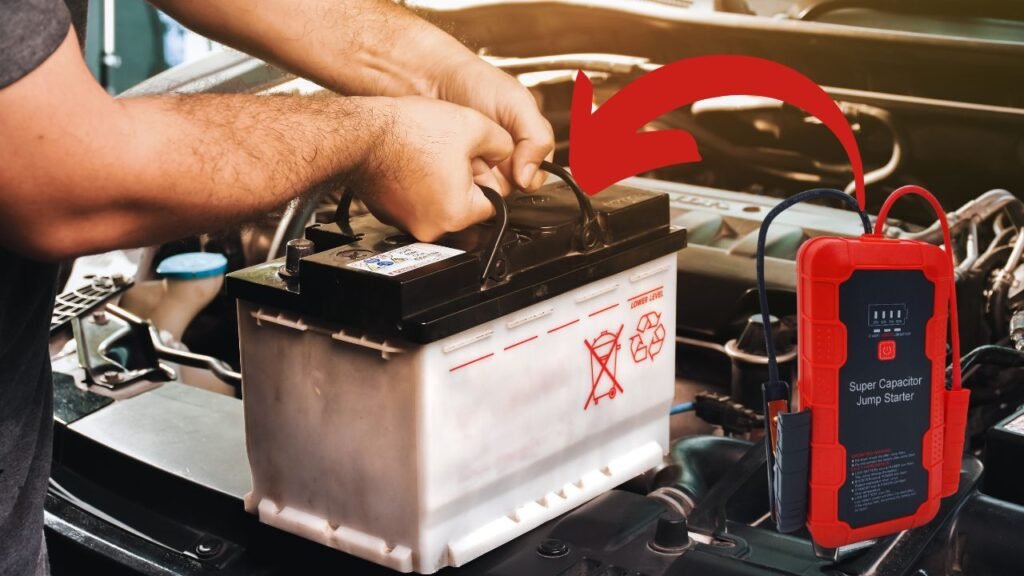Hey there! If you’ve ever been stuck with a car that won’t start, you know how frustrating it can be. I’ve been there too — stranded in the middle of nowhere, with no one around to help. That’s when I learned about portable jump starters.
So, what is a portable jump starter? It’s a small device that can jump-start your car without needing another vehicle. You just connect it to your car battery, and it gives the battery a boost to get you moving again. If you want to learn more about using a jump starter in different situations, check out this guide on jump starting a 24V battery with a 12V battery. It’s like having a little emergency backup plan in your trunk.”
But here’s the big question I had: Can a portable jump starter actually start a car with a completely dead battery? I was curious about this, and I think you might be too. Let’s dive in and see if these handy gadgets are really up to the job when your battery has completely died.
A Quick Look:
“A portable jump starter can start a car with a dead battery by delivering a burst of power, but it won’t charge the battery. It’s best for emergencies when you need to get moving quickly, but if the battery is old or damaged, a jump starter might not work. Make sure to choose a jump starter with a high cold-cranking amp (CCA) rating for better results.”
How Portable Jump Starters Work?

I’ve been in situations with a dead car battery more times than I’d like to admit, and portable jump starters have saved me more than once. A portable jump starter is like a small power bank, but for your car. It has three main parts: a lithium-ion battery, jumper cables, and clamps. If you want to know more about jumpstart costing in USA then you can visit this guide. Now let’s get back to the blog. Here’s how it works:
- Connect the Clamps: Start by connecting the red clamp to the positive terminal (+) of your car’s dead battery and the black clamp to the negative terminal (-). This creates a circuit that allows power to flow.
- Safety Circuit: Most portable jump starters include a built-in safety circuit, which can handle up to 12 volts and prevents sparks or damage if the clamps are connected incorrectly. This makes it much safer than using traditional jumper cables.
- Power Boost: Once connected, the jump starter delivers a burst of power—usually around 300 to 2,000 amps—depending on the model. This is enough to start most vehicles, from small cars to larger trucks or SUVs.
Can Portable Jump Starters Revive a Completely Dead Battery?

Now, here’s the main question: Can it really start a completely dead battery? Here’s what I’ve learned from my own experience:
- If the Battery Is Just Drained: If your car battery is only slightly drained (like if you left the lights on for 8 to 10 hours), a portable jump starter can usually help. I’ve used mine to start my car in such situations, and it worked within 5 to 10 seconds.
- If the Battery Is Old or Damaged: If the battery is over 5 years old or damaged, a portable jump starter might not be effective. In these cases, even a high-capacity jump starter with 1,000 to 2,000 amps might not help, and the battery might need replacement.
- Temperature Matters: Portable jump starters are typically rated to work between -4°F (-20°C) and 140°F (60°C). If it’s extremely cold (below -4°F), the device might take longer or need multiple attempts to get the car started.
How to use a Jump starter? A Step by Step Guide
Using a portable jump starter is pretty simple, but safety always comes first. I’ve used one many times, and here’s a step-by-step guide to help you do it safely:
Step 1: Make Sure the Jump Starter is Charged

Before you do anything, check that your jump starter is fully charged. Look for at least 80% charge on the indicator. This is super important. A jump starter with less than 50% charge might not be able to start your car, and you don’t want to be stuck out there.
Step 2: Turn Off Your Car and Connect the Cables

Turn off your car’s ignition and make sure everything is off—lights, radio, air conditioning. Now, grab the jump starter and connect the red clamp to the positive terminal (+) on your car battery. Then, connect the black clamp to a metal part of your car, at least 12 inches (30 cm) away from the battery. This helps to avoid any sparks.
Step 3: Start the Jump Starter and Wait

Once the cables are secure, turn on the jump starter. Most have a simple button or switch. Wait for about 30 to 60 seconds. This gives the jump starter time to transfer power to your car battery.
Step 4: Try to Start Your Car

After about 60 seconds, try to start your car. If it starts, great! Let the car run for at least 5-10 minutes to recharge the battery. If it doesn’t start, don’t panic. Wait another 1-2 minutes and try again.
Step 5: Disconnect the Jump Starter Carefully

If your car starts, turn off the jump starter. Then, remove the black clamp first, followed by the red clamp. Be careful not to touch the clamps together. Store the jump starter safely back in your car.
Troubleshooting and Problem Solving
I’ve had my fair share of trouble with portable jump starters, so I know how frustrating it can be when things don’t go as planned. Here are some common issues I’ve faced and how I managed to fix them:
- Jump Starter Not Working: Sometimes, I’ve connected everything, but the jump starter just wouldn’t work. The first thing I always check is if the jump starter is fully charged. If it’s low on power, it won’t do much. I also look at the clamps to make sure they’re tightly attached to the battery terminals. A loose connection can stop the jump starter from working.
- Wrong Connections: I’ve made this mistake before—connecting the clamps to the wrong terminals. It’s an easy error, especially if you’re in a rush or stressed. I learned to always double-check: the red clamp goes to the positive terminal, and the black one to the negative or a metal surface on the car. If you mess up, many jump starters have a safety feature that will alert you, but it’s best to be careful.
- Jump Starter Drains Quickly: I noticed that sometimes my jump starter didn’t hold a charge well. This usually happens if I haven’t used it for a while. I found that it’s important to recharge it every few months, even if I haven’t used it. Extreme temperatures, like leaving it in a hot car, can also drain the battery faster. Now, I keep it stored in a cool, dry place.
- Battery Still Dead After Jump Start: There were times when my car still wouldn’t start, even after using the jump starter. When this happened, I waited for a minute and tried again. Sometimes, the battery needs a second try. But if it still didn’t work, it usually meant there was a bigger problem with the car, like a faulty battery or an issue with the alternator. In that case, I had to call for help.
- Clamps or Cables Getting Hot: Once, I noticed the clamps getting too hot while trying to jump-start my car. I learned that this could be due to a bad connection or trying too long. Now, I disconnect and wait for a few minutes before trying again. This keeps things safe and prevents damage. If you’re looking for a reliable solution for these issues, consider using one of the best portable marine battery jump starters.
Essential Safety Tips
When using a portable jump starter, safety should always come first. I’ve had my fair share of moments trying to get my car started in all kinds of weather, and I’ve learned a few things the hard way. Here are five simple safety tips I always follow:
- Read the Manual
This might sound obvious, but seriously, read the manual. Every jump starter is a bit different. The manual will tell you how to use it safely and avoid mistakes. - Check the Charge
Make sure your jump starter is fully charged before you need it. I keep mine charged up and check it once a month. A dead jump starter won’t help you with a dead car battery. - Inspect the Cables and Clamps
Look at the cables and clamps for any signs of wear or damage. If the wires are frayed or the clamps are loose, don’t use it. Better safe than sorry! - Use the Right Connection Points
Always connect the red clamp to the positive (+) terminal and the black clamp to a metal part on your car (not the negative terminal). This keeps sparks from flying and prevents damage. - Stay Clear When Starting
Once everything is connected, step back a bit. Don’t lean over the battery when you try to start the car. If something goes wrong, you don’t want to be in the way.
FAQs about Portable Jump Starters
What size portable jump starter do I need for my vehicle?
The size of the jump starter you need depends on your vehicle’s engine size and battery requirements. For smaller cars, a jump starter with 400-600 cold-cranking amps (CCA) is typically sufficient. However, larger vehicles, such as trucks or SUVs, may require a jump starter with 800-1000 CCA or more to ensure reliable performance, especially in cold weather conditions.
How often should I charge my portable jump starter?
It’s important to keep your portable jump starter fully charged for it to work effectively. Most manufacturers recommend recharging the jump starter every 3-6 months or after each use. Check the device’s manual for specific charging instructions to maintain its battery life and readiness.
Can I use a portable jump starter for other purposes?
Yes, many modern portable jump starters come with additional features beyond jump-starting a car. They may include USB ports for charging electronic devices, built-in flashlights, and 12V outlets for powering other automotive accessories like air compressors. These extra features make them versatile tools for roadside emergencies
What is the difference between peak amps and cold-cranking amps (CCA) in jump starters?
Peak amps represent the maximum power a jump starter can deliver momentarily, while cold-cranking amps (CCA) indicate the amount of power it can provide consistently in cold conditions. When choosing a jump starter, focus more on the CCA rating, as it better reflects the device’s ability to start a vehicle with a dead battery, especially in colder temperatures.
Do all portable jump starters work on completely dead batteries?
Not all portable jump starters are capable of starting a completely dead battery. To ensure the best chances, choose a jump starter with a high cold-cranking amps (CCA) rating. Some jump starters also have a “manual override” feature, which allows them to deliver power even when the battery is extremely discharged.
Ali is a tech enthusiast and automotive aficionado, passionate about sharing insights on the latest innovations and industry trends.





